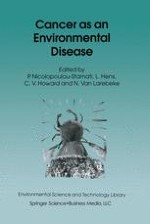
2004 | OriginalPaper | Buchkapitel
Introduction: Cancer and the Environment
Revisiting Traditional Views of Involuntary Exposure to Carcinogens
verfasst von : P. Nicolopoulou-Stamati, M. A. Pitsos
Erschienen in: Cancer as an Environmental Disease
Verlag: Springer Netherlands
Enthalten in: Professional Book Archive
Aktivieren Sie unsere intelligente Suche, um passende Fachinhalte oder Patente zu finden.
Wählen Sie Textabschnitte aus um mit Künstlicher Intelligenz passenden Patente zu finden. powered by
Markieren Sie Textabschnitte, um KI-gestützt weitere passende Inhalte zu finden. powered by
This book examines the relationship between environmental influences and the increasing incidence of cancer in humans. There are many changes taking place in the incidence and nature of a number of different diseases that face mankind. Because the environment in which we live is also in a state of flux, it is reasonable to enquire whether such changes might be associated with or indeed responsible for alterations in health patterns. In previous books in this series we have addressed the effects on health of pollution from waste (Nicolopoulou-Stamati et al., 2000) and also of chemical pollutants that disrupt hormones (Nicolopoulou-Stamati et al., 2001). Many of the effects addressed in those books had ‘soft’ endpoints that are awkward to assess, for example subtle changes in human neuro-behavioural patterns. With such endpoints it is notoriously difficult to design studies in human societies that will give emphatic answers, one way or the other. A major obstacle is the collection and maintenance of population-based data, for many of the areas of interest it simply does not exist.Therefore the study of cancer and its interactions with environmental influences appears, on first inspection, to be a tractable question. After all the incidence of cancer is not a ‘fuzzy’ endpoint, an individual either has it or does not. The basic data is, in fact, binary. In addition most developed countries maintain good cancer registries covering the whole population by region and by age. What is beyond any doubt is that the incidence of cancer in modern industrialised societies is rising rapidly (WHO, 2003). And yet there exists an enormous diversity of opinion between different experts as to the extent of the influence of the environment in the aetiology of cancer. Some members of the scientific establishment state that less than 5 per cent of cancers can be associated with environmental impacts, while others maintain that over 80 per cent are so influenced. Where does the truth lie?The relative contribution of genetic versus epigenetic factors continues to be a major area of controversy. Which particular environmental or epigenetic effects should be considered? Exposure to known carcinogens, be they chemical, physical or biological, is clearly relevant. What are the effects of the timing of exposure during different periods of life, when vulnerabilities can change? What proportion of the epigenetic influences are concerned with ‘lifestyle’, and therefore under the control of the individual, and what proportion are ‘imposed’ through unavoidable environmental pollution coming in air, water and food?There remain many more questions than answers. This book does not pretend to be able to provide definitive answers nor address all the areas of concern; the latter would require a much heftier tome. However the contributors to this book do gather much of the available literature together and help to focus on what we do understand and what we do not know. Carcinogenesis is generally accepted as a multi-factorial, multistage process and has been the subject of an enormous amount of research. Many molecular mechanisms and processes have been proposed for cancer development; however the identification of the initiating event leading to malignant transformation remains obscure. In post-modern societies, people are constantly exposed to a variety of known or potential carcinogens. The identification of data gaps is important because it points to ways forward. Ultimately we try to assess the plausibility of the environmental carcinogenesis hypothesis, applying widely accepted criteria on causality. Much remains to be debated, but we consider that this book will be of use to those who want to have a rapid introduction to the range of arguments available in this important area of human health.